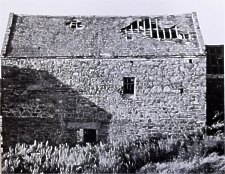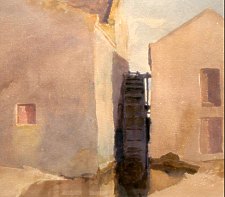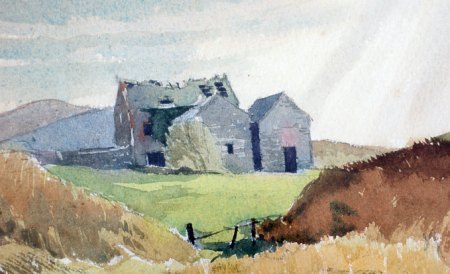(1) Lhen Mill
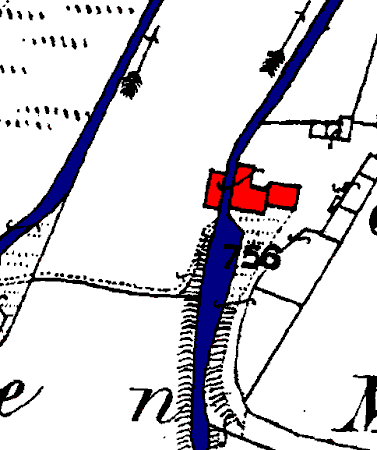
From 1868 O/S Plan II/11 - NX 379012
described as Corn Mill - there was a large dam south of the mill.
T A Brew, in a discussion re threshing
mills states "At the Lhen Mill, Andreas, we find the threshing
mill driven off the outer end of the waterwheel axle; the wheel hung
situated between the corn mill building and the threshing mill building"
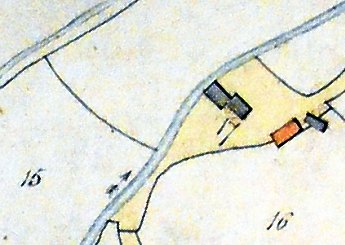
From 1827 plan UK NA MR 1/1291
Would appear to show that the threshing mill and the northward extension
were post this date;
the dam to the south was 15.81 ac
|
|
John Quine writing in 1896 describes the
mill setting:
A line of sand dunes extends along the N.W. coast of Jurby and Andreas, clothed
with turf and tufts of bent that scarce save the sandy soil from the abrasion
of the sea winds. By a gap in the dunes the Lhen finds exit to the sea. On
the slopes of the gap is a scattered hamlet. The coast road on the ridge of
the dunes dips at the gap to cross the river, by a grey and lichen-crusted
bridge. Above the bridge is a mill, with mill dust on windows and doors, and
ferns dripping moist in the wheel pit and on the mill wall. It is a place
with a modest air of antiquity. Four centuries ago Gilbert McHelly, the miller
of Lanmore, and tenant of the fresh water fishery in the Lhen river, was also
coroner of the shearing of Ayre. The rent of his mill was 20s, equal to that
of a quarter-land farm ; and he paid for the privileged office of coroner
the sum of 60s.
It is the most northerly of the Manx mills and lies on the flat northern plain
which is good agricultural land - the mill is fed from a small river the flow
of which is augmented by the Lhen trench, an artificial channel dug to drain
the curraughs to the east - it is possible that this drainage channel was dug
with the aim of supporting a mill as otherwise transport of grain to a distant
mill would be costly. A windmill was
constructed in Andreas in 1608 but was noted as out of action in 1643 and by
1648 its rental had been removed from the accounts. In 1648 there was however
an order from the Lord to clear and deepen the Lhen trench.
Because of the flat nature of the surrounding land it is difficult to provide
sufficient head of water - the dam feeding the mill was thus necessarily shallow,
the attached plan in the deed of sale in 1862 showed the Mill dam to be just
over 11 acres of otherwise good land, the dam could also cause flooding in adjacent
farmland further back along the trench during periods of heavy rainfall.
History of Mill
Pre 1600 the Lib Assedationis is the major,
if not the only, source of information as to owners of the Mill - this was updated
at the yearly sheading courts though not all of the early records have survived.
Lib Assed
1515 Gilbert McHelly for the mill of Lanmore, with the fresh-water fishing
there, demised to him .- 20s (also held 27s. 4d. together with Fynlo McHelly
13s. 8d. for 2 tenements and 2 quarters of land (total 41s) in Balyhestyn
- this tenancy was Ballahestine (later known as Ballasteen) - Gilbert and
Finlo were possibly brothers - Gilbert, as was common for millers, also held
a brewing licence)
1529 Gilbt mc helly for mill of Lanmore + fishing - 20s (also held the above
27s 4d together with [] mc gil[]aght for Gilbt mc helly for the 13s 8d - possibly
Gilbt was the underage son & heir to Finlo)
1554 [] mc helly for mill of Lamore - 20s (also held the above 27s 4d together
with John mc C[hristin] who held the 13s 8d)
1580 Gilbt mc helly, Jon mc Christen 6s 8d for mill - 20s (also held the whole
of the 41s in Balyhestyn)
By 1600 the name mc helly had become today's Kelly - sometime between
1554 and 1580 John Christian had acquired a third share in the mill. Post 1600
there is a complete sequence of annual entries in the Libri
Vastarum.which noted changes in tenancy.
Lib Vast
1601: John Christian drawn - Gilbert Kelly 13s 4d, Phillip Christian 6s 8d
- Phillip entered by the gift of Jo: Christian & by the delivery of a
straw in Court
1602: Gilbert Kelly 6s 8d, Ewan Christian 6s 8d, Phillip Christian 6s 8d -
Ewan Christian is entered by consent of Gilbt Kelly in court and by vertue
of a bill of bargaine from the said Gilbt, Ewan Kelly his son and Kathrin
his wife, confirmed under the hands of the officers.
1613: Phillip Christian dawn - Gilbert Kelly 10s Ewan Christian 10s - Phillip
Christian hath [passed] away his estate for ever by delivery of the strawe
in court to Euan Chrisian and Gilbt Kelly who are both entered half and half
thoughout the whole and soe to [operate] it henceforth by both their agreemts
in court.
Gilbert Kelly left no sons to carry on the Mill and it passed to his daughter
Joney who married John Lace. They would then appear to have leased to mill to
tenant millers.
By the mid 17th century sufficient parish and other records exist to provide
a list of millers - see the section "Lhen Mill House" forming pp68/9
in Sally MCambridges 'Andreas' book.
Post 1704 all deeds of sale and mortgage had to be officially recorded thus
providing a further source of information.
It wouls appear that the mill was put out of action by the dift of sand blocking
its tail race, thus two neighbours gave land to cut a new tail race:
NSS May 1746 26
dated 5 Oct 1744;recites that the water course from Lane Moar Miln has for
some years past filled up with a drift of sand which has dammed up the water
in the miln so that it cannot grind, which is a great inconvenience to neighbouring
tenants - as the owners of the mill have undertaken to make a course outwards
from the highway to the sea which would pass through the land of Patt Christian
+ Thos Corlett who, in hope that miln shall grind as formerly, give the necessary
land to the miln owners; witt Jno Kneen x, Phillip Ellison x
NSS May 1810 6
dated 28 Jan 1809; John Corlett(Glentramon) + wife Ann sell for £600
to John Duke of Atholl our half of the water corn mill in Andreas known as
Lhane Mooar Mill together with all the tenant-right grist suit and soken as
well as the miller's house, dam-head etc; witt Frederick LaMothe, David Hannay
NSS May 1810 8
dated 23 May 1809; John Caesar Gelling(Belle Vue) sells for £600(Brit)
half of that Water corn mill in Andreas known as Lhane Moare Mill together
with all the tenant-right grist suit and soken as well as the miller's house,
dam-head etc the the Duke of Atholl; witt Edw Olwin, Willm Geneste
Possibly the Duke had purchased the Mill to protect his interests in other
property - he had already in 1783 petitioned the then Governor Dawson about
proposals to cut a new drain.
In 1824 James McCrone was writing to the Duke. "What is to be done about
the Lhen Moar Mill ? Unless it is immediately repaired at a cost of about £200
it will become a complete ruin".[AP_124(3rd)_25]
Following the Duke's departure the Mill was one of the many properties sold
to James Holmes the banker who paid £2,130 for the mill together with
the other ducal lands in Andreas [UK NA LRRO 21/8] - following his death and
the failure of his bank these properties were sold off - the Mill plus mill
croft was sold to William Fine Moore [reg deed December 1862 #27] for £1014,
the owner of Tromode mill + works. He sold it to
Thomas Clarke on 9th November 1869 [deed not yet located thus not sure of the
purchase price] but allowed Clarke to owe him £250. Clarke borrowed another
£750 from Archdeacon Joseph Moore (elder brother of W F Moore) and some
18 months later a further £150 from the Andreas
Benevolent Society. This highly leveraged arrangment soon collapsed resulting
a a coroner's sale to John Thomas Clucas.
Registered Deed Dec 1862 #27
dated 30 Oct 1858;After recital of the decree allowing sale of real property
of the late James Holmes(Banker) and in particular the Lhan Mill, Millers
croft (11ac) + other associated premises in the parish of Andreas as shown
in Lot 9 plan D;for which the highest bid of £1014 was paid by James
Corlett acting as agent for William Fine Moore(Tromode);witt Geo Maley, Chas
Wm Beckwith; [Plan D annexed]
Registered Deed Jun 1869 #13
dated 28 May 1869;Thomas Clarke(Lhen Mill) + wife Margaret Ann als Kaneen
ack indebted to Andreas Benevolent Society(John Sayle(Regaby) president) for
£150 @ 5% and give as security those lands and premises known as Lhen
Mill and Miller's Croft in the parish of Andreas purchased from Wm Fine Moore
by deed dated 9 Nov 1869; Witt John Corlett, Thomas Kneale
Registered Deed Aug 1874 #14
dated 10 Apr 1874;Recites that Thomas Clarke(Lhane mill) + wife Margaret
Ann did pass B + S by deed dated 9 Nov 1867 to Joseph Christian Moore Archdeacon
+ trustee of endowment fund for Christ Church Maughold for £750 giving
as security the Lhane Mill, Millers Croft and premises in parish of Andreas
purchased from W F Moore by deed dated 9 Nov 1867, and also passed B+S to
the Andreas Benevolent Society
by deed dated 28 May 1869 for £150 - excution given on 8 Dec 1873 agt
Clarke for £39 7s 6d in favour Archdeacon More + for the £150
+ interest from 28 May 1871 in favour of Benevolent Soc(Edward Kneen president)
- coroner's sale 10 Mar 1874 sd property sold to J T Clucas (thro agent Daniel
Cormode) for £1161;
Registered Deed Aug 1874 #17
dated 12 Aug 1874;recites that by deed dated 9 Nov 1867 Thomas Clarke acked
indebted for £250 to Wm Moore(Cronkbourne, Braddan) @ 6% (5% if paid
punctually) giving as security the Lhane Mill Millers Croft and premises in
parish of Andreas on which there is now owing £295 13s 10d which John
T Clucas (Ballakilley, Rushen) agrees to pay for assignment of sd deed; Witt
Alfred Moore
In 1841 census William Cashen was miller with 15 year old George Moore his
apprentice - possibly a relative of his wife Esther Moore.
Manx Sun, 21st June 1851 carried the report
FATAL ACCIDENT AT KIRK ANDREAS.
On Wednesday last an accident occurred at the Lhen Mill, Andreas, which in
the case of a young man named Gawne proved fatal, and was attended with very
serious consequences to another person. It appears that Gawne who was the
miller proceeded to stop the supply of water by shutting the sluice-gate.
Owing to the great pressure of water, however, the gate did not move freely,
and in his endeavours to force it down his foot slipped and he fell in, and
was dreadfully crushed between the water-wheel and the wall. While in this
perilous sitnation. a young man, who had brought a cart-load of corn to the
mill, for the purpose of being ground, ran to his assistance, and while endeavouring
to extricate the unfortunate miller also fell in. Alter a short time both
parties were taken out, and immediately conveyed to the nearest residence,
the neighbours promptly doing all in their power to alleviate the sufferings
of the poor men. Gawne, who belonged to Kirk Bride, was so seriously injured,
that he died within twenty-four hours of the occurrence ; the other young
man still lies in a precarious state.
The young miller was Charles Gawne, noted as 19 in the Kk Bride burial register
but 22 years old in the 1851 census, one of two young servant millers to John
Cowley who is noted as a farmer of 50ac in the 1851 census, the other servant
miller being 16 year old Wm Kelly,
By the 1861 census the miller was noted as Thomas Cowley(brother of the above
John) assisted by his son Thomas - he was noted in Andreas as leaving
the mill around 1865 following the death of his brother and was succeeded by
Thomas Clarke
Mona's Herald 26th January 1874
Coroner's Sale of Mill, Miller's Croft, &c. Andreas.
TO be Sold by Auction, by the Coroner of Ayre Sheading (under due process
of law), on TUESDAY, the 10th March, 1874, that capital ESTATE and PREMISES,
situate in the parish of Andreas, known as the Lhen Mill, with dwelling-house,
Out-offices, and about 27 acres of Land in connection therewith. Also a certain
substantial dwelling-house, garden, and premises, adjoining the road and forming
part of the quarterland of Ballacunner, in the said parish of Andreas . Also,
sundry household effects, pair wooden scales and weights, trucks, corn measures,
a few sacks, lot timber, &c, the property of Mr Thomas Clarke.
Sale of effects to take place at the mill, at 1 o'clock ; the mill and miller
's croft, at 2 o'clock ; and the dwelling-house and garden, on the premises,
Ballacunner, at 3 o'clock, afternoon. The sale merits the special attention
of millers and capitalists, as the mill is situate in a fertile agricultural
district, and has all along been largely patronised by the farmers in the
locality.
Further particulars way be known on application to the Coroner, or to J.
C. LaMothe, Esq., Advocate. J. BRIDSON, Coroner of Ayre Sheading. Market-place,
Ramsey.
Isle of Man Times, 14th March 1874
LHEN-MOAR MILL.
On Tuesday, Mr Bridson sold by auction, the property known as the Lhen Mill,
containing, besides dwelling house and offices, land to the extent of about
27 acres. The lot was knocked down to J. T. Clucas, Esq., for £1,140
Complaints about damage being done by flooding along the Lhen trench finally
resulted in some attention and a bill to transfer authority over the trench
to the Highways Board and repeal certain parts of an 1875 act which had allowed
the situation to deteriorate.
Mona's Herald 25th April 1906
LAND DRAINAGE.
This Bill came up for second reading.
Mr Radcliffe gave an interesting statement on the history of drainage in
the north chiefly dealing with the Lhen trench. He traced the connection of
his father with the construction of that drain, the possession of the Lhen
mill by James Holmes, the banker, then by the Speaker's [of the Keys A.W Moore]
father, and afterwards by a man named Clarke who made on alteration in the
sluices, which drained the water 18in. higher, to the injury of the level
land behind. He quoted the late John Thomas Clucas as asserting that the drainage
of the district affected by the drain could only be properly carried out if
the Lhen Drainage Bill was done away with. He described the 1875 Act as a
splendid one, but lacking power. The object of the new Bill was to provide
the power to give that Act force. The Bill would place all water courses under
the control of the Highway Board; and that the expense works carried out shall
be levied by rate on the lands affected. It repealed the section which had
been a hindrance to the cleaning of drains. He had confidence in asking the
House to read the Bill a second time
Mr Quine said he worked at the Lhen mill 65 years ago. He knew that a great
deal of injury was done to the land above the mill. It was then said that
if the mill was pulled down, and the land of the dam under water used for
growing wheat, it would have paid for the mill in a few years. He seconded
the motion.
It would appear that Clarke had constructed a weir across the water course
thus effectively turning the Lhen Trench into a mill dam. The result was flooding
of property adjacent to the trench which was finally resolved in 1920 when the
Highways Board required the removal of this weir.
Isle of Man Times, Saturday, January 10, 1920
THE LHEN MOAR DRAIN.
Mill-owners' Claim.
The hearing of the claim of Mr J. D. Clucas, proprietor of the Lhane water
corn mill, for compensation in respect of the compulsory removal of his mill
weir, in terms of the order recently made by the Highway Board under the Drainage
Acts 1875 to 1917, has occupied several days. A number of witnesses were examined
on behalf of Mr Clucas, and also of Messrs Callister, Brooke, and other land
landowners in the district affected by the Lhane,who are the promoters of
the proceedings. It was alleged by the promoters that owing to silting up,
due to neglect of cleaning of the ancient dam of the mill, the weir in connection
therewith had become useless for mill purposes, and that in substitution the
present weir was built by the late Mr J. Clucas, then owner of the premises,
which practically turned the Lhen Trench into a mill-dam, and impounded in
it the water for the use of the mill, with the result that serious flooding
and extensive damage has been caused to the adjacent lands of the promoters.
This was not admitted by Mr. J. D. Clucas.
Attempts made during several years past by negotiation to remedy this state
of things have failed, and finally proceedings were taken by the promoters
under the Land Drainage Act of 1875 to have the weir removed. It was found
that the powers of the Highway Board, who are the authority under the Act.
were insufficient for the purposes sought to be effected, and an amended Act
was obtained from the Legislature, under which after hearing all parties concerned,
the Highway Board decided that the mill weir was the cause of the obstruction
to the the passage of the water of the Lhen Trench, also of the flooding the
lands in question, and ordered it to be removed upon compensation being made
to Mr Clucas under the provisions of the Act.
The arbitrators were Mr E. Martin (for Mr Clucas). Mr W. V. Cowley (for the
promoters). and Mr Carine. (for the tenant). Mr J. W. Cannan was appointed
umpire and chairman and the sittings were held at Ramsey. Mr. Clucas put in
a claim for £12,941 10s being the cost of an oil engine and working
and renewal of same in substitution for the water power of which he would
he deprived and the tenant, John Kneen, also claimed a sum of £991 16s
8d in respect of the injury to his interests during the remainder of his lease.
Mr Nelson appeared for the promoters. Mr. Kewley for Mr Clucas, and Mr. Hyde
for the tenant. Mr Kewley objected to the claims being heard together, and
Mr Clucas's case was taken first and Mr Carine left the bench. Considerable
evidence was given, the promoters witnesses estimating the compensation to
be paid to Mr. Clucas from £500 to £800. Thc arbitrators are considering
their award.
Killane mill in Jurby was likewise fed by a curragh
drainage trench and by the 1920s there was agitation to close the water supply
to this mill thus allowing its large dam to be reused as agricultural land.
This Mill was featured in a second report
of the Industrial Archaeology Group
References
Sally McCambridge Andreas priv pub 2005 - based on the extensive research
over many years of Donald Dugdale (his earlier manuscript Andreas People
2000 is held by the Manx Museum)
2


